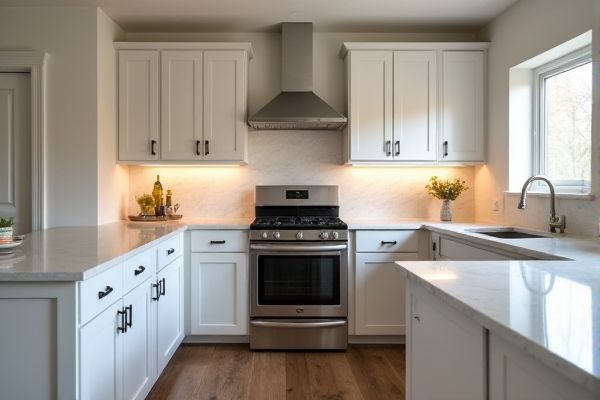
Deep cabinets offer increased storage capacity ideal for larger kitchen items, while shallow cabinets provide easier access and better organization for frequently used utensils. Explore the rest of the article to determine which cabinet style best suits Your kitchen needs and personal preferences.
Table of Comparison
| Feature | Deep Cabinets | Shallow Cabinets |
|---|---|---|
| Depth | 18-24 inches | 12-15 inches |
| Storage Capacity | High - accommodates large items and bulk storage | Low to medium - ideal for small items and easy access |
| Space Requirement | Requires more floor space | Saves floor space, ideal for small kitchens |
| Accessibility | Can be harder to reach items at the back | Easy access to all contents |
| Cost | Generally more expensive due to size | More affordable and versatile |
| Common Use | Best for large kitchens, pantry storage | Best for compact kitchens, limited wall space |
Introduction to Deep vs Shallow Cabinets
Deep cabinets offer greater storage capacity, ideal for larger kitchen items and bulkier appliances, maximizing spatial efficiency in kitchens with ample room. Shallow cabinets suit smaller spaces by providing easy access and better organization for frequently used items, reducing clutter and improving workflow. Choosing between deep and shallow cabinets depends on kitchen size, storage needs, and user convenience priorities.
Key Differences Between Deep and Shallow Cabinets
Deep cabinets offer increased storage capacity, making them ideal for bulky items and maximizing kitchen space efficiency. Shallow cabinets, typically easier to access and organize, reduce clutter by limiting storage depth, preventing items from getting lost in the back. Your choice depends on balancing storage needs with ease of access and kitchen layout.
Space Optimization: Deep vs Shallow Cabinets
Deep cabinets maximize vertical storage capacity, allowing for larger kitchen items like pots and pans to be stored efficiently, reducing clutter on countertops. Shallow cabinets enhance accessibility and help organize frequently used items, preventing wasted space behind stored objects. Optimizing space often involves a mix of both, balancing depth for bulky items and shallow options for easy reach and better visibility.
Storage Capacity Comparison
Deep cabinets offer significantly more storage capacity compared to shallow cabinets, making them ideal for bulky kitchen items and large pots. Shallow cabinets provide easier access but limit vertical and overall storage space, best suited for smaller items and frequently used utensils. Choosing between the two depends on balancing storage needs with kitchen layout and accessibility preferences.
Accessibility and Convenience
Shallow cabinets offer enhanced accessibility by allowing items to be easily visible and within reach, reducing the need to dig through cluttered spaces. Deep cabinets provide greater storage capacity but can hinder convenience as items at the back may become difficult to access without removing front objects. Choosing the appropriate depth balances storage needs with ease of use, improving overall kitchen efficiency.
Best Uses for Deep Cabinets
Deep cabinets provide ample storage space ideal for bulky kitchen appliances, large pots, and pans, maximizing organization in spacious kitchens. Their depth accommodates oversized items that shallow cabinets cannot, making them perfect for homeowners who require extensive storage capacity. Deep cabinets also work well in pantry areas, allowing for efficient stacking and easy access to food supplies and cookware.
Ideal Situations for Shallow Cabinets
Shallow cabinets are ideal for small kitchens or narrow spaces where maximizing floor space is essential. Their reduced depth allows for easier access to items, preventing clutter and improving organization in tight areas. You can efficiently store frequently used items without overwhelming your workspace, making shallow cabinets a practical choice for compact layouts.
Design and Aesthetic Considerations
Deep cabinets offer ample storage space and create a streamlined, built-in look that enhances kitchen functionality, while shallow cabinets contribute to a more open and airy design, preventing a cramped feel in small spaces. The choice between deep and shallow cabinets significantly influences the overall kitchen style, with deep cabinets promoting a more traditional or luxurious aesthetic and shallow cabinets aligning with modern, minimalist designs. Balancing cabinet depth is essential to achieve both visual appeal and practical storage tailored to the room's size and layout.
Cost Implications of Cabinet Depth
Deep cabinets generally incur higher costs due to the increased materials and construction complexity required compared to shallow cabinets. The added depth can also lead to higher shipping and installation expenses, impacting the overall budget. Shallow cabinets tend to be more cost-effective while offering sufficient storage for smaller spaces, making them a budget-friendly choice.
Choosing the Right Cabinet Depth for Your Space
Choosing the right cabinet depth balances storage needs with room functionality, where deep cabinets typically range from 24 to 30 inches, offering ample space for large items and bulk storage. Shallow cabinets, around 12 to 15 inches deep, maximize space efficiency in smaller rooms, preventing overcrowding and enhancing accessibility. Assessing kitchen size, workflow, and inventory volume ensures the optimal cabinet depth to streamline organization and maintain aesthetic harmony.
 homyna.com
homyna.com